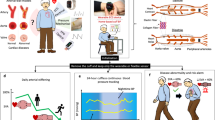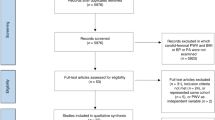Abstract
Aortic stiffness is predictive of cardiovascular diseases (CVD) and mortality in lifestyle-related diseases. The cardio-ankle vascular index (CAVI), a new index of arterial stiffness, was recently developed by measuring of pulse wave velocity (PWV) and blood pressure (BP). CAVI is adjusted for BP based on stiffness parameter β and is less influenced by BP, suggesting its superiority over brachial-ankle PWV (baPWV). However, there are currently no reports on the usefulness of CAVI as an atherogenic index in obesity and metabolic syndrome (MS). Among the 325 obese Japanese outpatients enrolled in the multi-centered Japan Obesity and Metabolic Syndrome Study, 216 patients (67%) met the criteria of MS according to the modified National Cholesterol Education Program–Adult Treatment Panel III. CAVI values were significantly higher in MS than in non-MS patients, whereas there was no significant difference in body mass index, total cholesterol, and low-density lipoprotein-cholesterol between both groups. CAVI values were weakly correlated with BP but closely correlated with the severity of MS and MS-related parameters such as hypoadiponectinemia, relative to baPWV. Furthermore, weight-reduction therapy through diet and exercise over a 3-month period significantly decreased CAVI values in parallel with increasing adiponectin. This study demonstrates for the first time that CAVI is a good indicator of arterial stiffness. It is closely correlated with the severity of MS and CVD risks in obesity and independent of BP, and is thus superior to baPWV. Therefore, the determination of arterial stiffness by CAVI may be useful for evaluating and managing the CVD risks of MS patients.
Similar content being viewed by others
Article PDF
References
Eckel RH, Grundy SM, Zimmet PZ : The metabolic syndrome. Lancet 2005; 365: 1415–1428.
Isomaa B, Almgren P, Tuomi T, et al: Cardiovascular morbidity and mortality associated with the metabolic syndrome. Diabetes Care 2001; 24: 683–689.
Ridker PM, Buring JE, Cook NR, Rifai N : C-reactive protein, the metabolic syndrome, and risk of incident cardiovascular events: an 8-year follow-up of 14 719 initially healthy American women. Circulation 2003; 107: 391–397.
Cruickshank K, Riste L, Anderson SG, Wright JS, Dunn G, Gosling RG : Aortic pulse-wave velocity and its relationship to mortality in diabetes and glucose intolerance: an integrated index of vascular function? Circulation 2002; 106: 2085–2090.
Satoh N, Ogawa Y, Usui T, et al: Antiatherogenic effect of pioglitazone in type 2 diabetic patients irrespective of the responsiveness to its antidiabetic effect. Diabetes Care 2003; 26: 2493–2499.
Matsui Y, Kario K, Ishikawa J, Eguchi K, Hoshide S, Shimada K : Reproducibility of arterial stiffness indices (pulse wave velocity and augmentation index) simultaneously assessed by automated pulse wave analysis and their associated risk factors in essential hypertensive patients. Hypertens Res 2004; 27: 851–857.
Ito N, Ohishi M, Takagi T, et al: Clinical usefulness and limitations of brachial-ankle pulse wave velocity in the evaluation of cardiovascular complications in hypertensive patients. Hypertens Res 2006; 29: 989–995.
Yambe T, Yoshizawa M, Saijo Y, et al: Brachio-ankle pulse wave velocity and cardio-ankle vascular index (CAVI). Biomed Pharmacother 2004; 58: S95–S98.
Kubozono T, Miyata M, Ueyama K, et al: Clinical significance and reproducibility of new arterial distensibility index. Circ J 2007; 71: 89–94.
Shirai K, Utino J, Otsuka K, Takata M : A novel blood pressure–independent arterial wall stiffness parameter; cardioankle vascular index (CAVI). J Atheroscler Thromb 2006; 13: 101–107.
Mizuguchi Y, Oishi Y, Tanaka H, et al: Arterial stiffness is associated with left ventricular diastolic function in patients with cardiovascular risk factors: early detection with the use of cardio-ankle vascular index and ultrasonic strain imaging. J Card Fail 2007; 13: 744–751.
Takaki A, Ogawa H, Wakeyama T, et al: Cardio-ankle vascular index is a new noninvasive parameter of arterial stiffness. Circ J 2007; 71: 1710–1714.
Nakamura K, Tomaru T, Yamamura S, Miyashita Y, Shirai K, Noike H : Cardio-ankle vascular index is a candidate predictor of coronary atherosclerosis. Circ J 2008; 72: 598–604.
Esposito K, Pontillo A, Di Palo C, et al: Effect of weight loss and lifestyle changes on vascular inflammatory markers in obese women: a randomized trial. JAMA 2003; 289: 1799–1804.
Dengel DR, Kelly AS, Olson TP, Kaiser DR, Dengel JL, Bank AJ : Effects of weight loss on insulin sensitivity and arterial stiffness in overweight adults. Metabolism 2006; 55: 907–911.
Expert Panel on Detection, Evaluation, and Treatment of High Blood Cholesterol in Adults: Executive Summary of the Third Report of the National Cholesterol Education Program (NCEP) Expert Panel on Detection, Evaluation, and Treatment of High Blood Cholesterol in Adults (Adult Treatment Panal III). JAMA 2001; 285: 2486–2497.
The Examination Committee of Criteria for Metabolic Syndrome: Definition and criteria of metabolic syndrome. J Jpn Soc Int Med 2005; 94: 794–809.
Yamashina A, Tomiyama H, Takeda K, et al: Validity, reproducibility, and clinical significance of noninvasive brachial-ankle pulse wave velocity measurement. Hypertens Res 2002; 25: 359–364.
Japan Atherosclerosis Society: Japan Atherosclerosis Society Guidelines for Diagnosis and Treatment of Atherosclerotic Cardiovascular Diseases. Tokyo, Japan Atherosclerosis Society, 2002, pp 24–26.
Japanese Society of Hypertension: Japanese Society of Hypertension Guidelines for the Management of Hypertension (JSH 2004). Hypertens Res 2006: 29: S1–S105.
Safar ME, Thomas F, Blacher J, et al: Metabolic syndrome and age-related progression of aortic stiffness. J Am Coll Cardiol 2006; 47: 72–75.
Kadowaki T, Yamauchi T, Kubota N, Hara K, Ueki K, Tobe K : Adiponectin and adiponectin receptors in insulin resistance, diabetes, and the metabolic syndrome. J Clin Invest 2006; 116: 1784–1792.
Matsuzawa Y, Funahashi T, Kihara S, Shimomura I : Adiponectin and metabolic syndrome. Arterioscler Thromb Vasc Biol 2004; 24: 29–33.
Sipila K, Koivistoinen T, Moklanen L, et al: Metabolic syndrome and arterial stiffness: the Health 2000 Survey. Metabolism 2007; 56: 320–326.
Ohnishi H, Saitoh S, Takagi S, et al: Pulse wave velocity as an indicator of atherosclerosis in impaired fasting glucose: the Tanno and Sobetsu study. Diabetes Care 2003; 26: 437–440.
Mattace-Raso FU, van der Cammen TJ, Hofman A, et al: Arterial stiffness and risk of coronary heart disease and stroke: the Rotterdam Study. Circulation 2006; 113: 657–663.
Ibata J, Sasaki H, Kakimoto T, et al: Cardio-ankle vascular index measures arterial wall stiffness independent of blood pressure. Diabetes Res Clin Pract 2008; 80: 265–270.
Takeuchi H, Saitoh S, Takagi S, et al: Metabolic syndrome and cardiac disease in Japanese men: applicability of the concept of metabolic syndrome defined by the National Cholesterol Education Program–Adult Treatment Panel III to Japanese men–the Tanno and Sobetsu Study. Hypertens Res 2005; 28: 203–208.
Zieman SJ, Melenovsky V, Kass DA : Mechanisms, pathophysiology, and therapy of arterial stiffness. Arterioscler Thromb Vasc Biol 2005; 25: 932–943.
Barinas-Mitchell E, Kuller LH, Sutton-Tyrrell K, et al: Effect of weight loss and nutritional intervention on arterial stiffness in type 2 diabetes. Diabetes Care 2006; 29: 2218–2222.
Rector RS, Turk JR, Sun GY, et al: Short-term lifestyle modification alters circulating biomarkers of endothelial health in sedentary, overweight adults. Appl Physiol Nutr Metab 2006; 31: 512–517.
Author information
Authors and Affiliations
Consortia
Corresponding author
Rights and permissions
About this article
Cite this article
Satoh, N., Shimatsu, A., Kato, Y. et al. Evaluation of the Cardio-Ankle Vascular Index, a New Indicator of Arterial Stiffness Independent of Blood Pressure, in Obesity and Metabolic Syndrome. Hypertens Res 31, 1921–1930 (2008). https://doi.org/10.1291/hypres.31.1921
Received:
Accepted:
Issue date:
DOI: https://doi.org/10.1291/hypres.31.1921
Keywords
This article is cited by
-
CAVI (Cardio-Ankle Vascular Index) as an independent predictor of hypertensive response to exercise
BMC Cardiovascular Disorders (2024)
-
Arterial Stiffness and its Impact on Cardiovascular Health
Current Cardiology Reports (2023)
-
Cardio-ankle vascular index is more closely associated than brachial-ankle pulse wave velocity with arterial damage and risk of cardiovascular disease in patients with diabetes
BMC Cardiovascular Disorders (2022)
-
Analysis of time-dependent changes in the FIB4 index in patients with obesity receiving weight reduction therapy
Scientific Reports (2022)
-
Positive effect of total knee arthroplasty on progression of arteriosclerosis evaluated by cardio-ankle vascular index
Archives of Orthopaedic and Trauma Surgery (2022)



